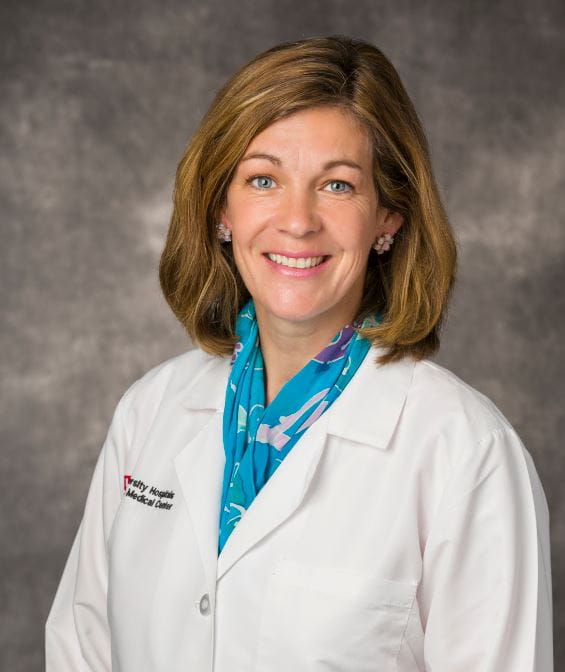Where Health Meets Aesthetics
October 30, 2017
Whenever possible, breast surgeon Jill Dietz, MD, Director of Breast Center Operations, UH Seidman Cancer Center, and Associate Professor of Surgery, Case Western Reserve University School of Medicine, takes an oncoplastic approach to breast cancer procedures.
 Jill Dietz, MD
Jill Dietz, MD“First we started doing mastectomies that spared the nipple,” says Dr. Dietz, “then we realized how deformed large-breasted women could be after a lumpectomy, so we started doing a lumpectomy at the same time as a reduction. Then from there, the techniques improved and we started trying more advanced techniques. Oncoplastic surgery is a philosophy. We pay attention not only to the tumor characteristics, but also the patient’s breast size and shape and her feelings about her breasts in terms of shape, size, sensation and importance to her identity and intimacy. All this information helps us determine which approach will give her the best result.”
“Breast cancer is now such a multidisciplinary field,” she adds. “We have radiologists who are diagnosing women earlier. We have medical oncologists who are shrinking the tumor so we can take out less tissue. We have radiation oncologists who can often decrease the time period or dose of radiation. Other members of our team include pathologists, genetics and lymphedema specialists. Everyone is involved in the care of the patient. Oncoplastic surgery relies on all members of the team to think about the best outcomes of the patient.”
Nearly any breast cancer surgery can be oncoplastic, to varying degrees, Dr. Dietz says.
”It’s the combining of a cancer operation with a reconstructive surgery in order to maintain breast shape,” she says. “You can think about that in many different ways. It can be as simple as where you place the incision. If the incision can be placed under the breast, the scar may be invisible to the patient. You can also hide the scar in the areolar edge or in the axilla.”
Dr. Dietz says she’s often able to use an oncoplastic approach for patients with larger or ptotic breasts.
“Instead of leaving a hole where the cancer was, which can cause breast deformity over time, you can remove the cancer but also reduce the skin envelope,” she says. “You take the excess skin away and what you end up with is a breast that is a bit smaller and firmer and without deformity.”
Outcomes for oncoplastic surgery are generally very good, Dr. Dietz says.
“Compared with lumpectomy alone, recent literature shows that complication rates for oncoplastic procedures are similar,” she says. “However, re-excision rates are less because you’re taking more tissue out. Oncoplastic techniques not only provide a better cosmetic and oncologic outcome, they allow more women to become candidates for breast conservation.”
Women who require a mastectomy can also undergo an oncoplastic approach.
“Breast surgeons used to take a big ellipse of skin around the nipple areolar complex, remove it and the breast tissue and reconstruct with in a tissue expander,” Dr. Dietz says. “Now very often we’re able to save the entire skin envelope by performing a nipple-sparing mastectomy. It’s possible you don’t even see a scar because you can access the entire breast from an incision in the inframammic ridge.”
For very large-breasted women who require mastectomy but who are not a great candidate for a reconstruction due to comorbidities, the Goldilocks mastectomy is a good option, Dr. Dietz says. These women have their breast tissue removed and small breast mounds are made from their deepithelized subcutaneous tissue.
“There’s no implant or foreign body, and no large surgery to transfer tissue from a different area of the body,” says Dr. Dietz. “It’s a way to give someone who isn’t a good candidate for reconstruction some breast mounds.”
The goal for every patient, Dr. Dietz says, is three-fold: Remove the cancer, avoid causing a functional problem and create the best possible cosmetic result.
“These things are not mutually exclusive,” she says. “The strides we’ve been able to make in surgery are just unbelievable. Not all surgeons do this – a lot just do what they’ve done since their training, and that’s make a big incision and remove the tumor. A few years later, once the fluid collection has resorbed, there can be significant asymmetry and deformity, and we’re trying to avoid that.”
The breast surgery team at UH Seidman Cancer Center includes Dr. Dietz, as well as Pamela Li, MD; Bob Shenk, MD; Megan Miller, MD; and Lisa Rock, MD.
For more information on oncoplastic breast surgery services or to make a referral, please email CancerInnovations@UHhospitals.org.


